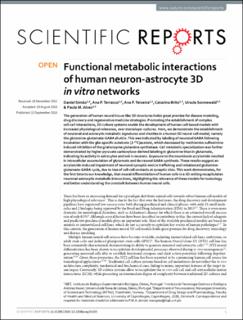| dc.contributor.author | Simao, Daniel | |
| dc.contributor.author | Terrasso, Ana P | |
| dc.contributor.author | Teixeira, Ana P | |
| dc.contributor.author | Brito, Catarina | |
| dc.contributor.author | Sonnewald, Ursula | |
| dc.contributor.author | Alves, Paula M. | |
| dc.date.accessioned | 2020-04-28T13:51:50Z | |
| dc.date.available | 2020-04-28T13:51:50Z | |
| dc.date.created | 2016-12-01T15:01:28Z | |
| dc.date.issued | 2016 | |
| dc.identifier.citation | Scientific Reports. 2016, 6 . | en_US |
| dc.identifier.issn | 2045-2322 | |
| dc.identifier.uri | https://hdl.handle.net/11250/2652805 | |
| dc.description.abstract | The generation of human neural tissue-like 3D structures holds great promise for disease modeling, drug discovery and regenerative medicine strategies. Promoting the establishment of complex cell-cell interactions, 3D culture systems enable the development of human cell-based models with increased physiological relevance, over monolayer cultures. Here, we demonstrate the establishment of neuronal and astrocytic metabolic signatures and shuttles in a human 3D neural cell model, namely the glutamine-glutamate-GABA shuttle. This was indicated by labeling of neuronal GABA following incubation with the glia-specific substrate [2-13C]acetate, which decreased by methionine sulfoximine-induced inhibition of the glial enzyme glutamine synthetase. Cell metabolic specialization was further demonstrated by higher pyruvate carboxylase-derived labeling in glutamine than in glutamate, indicating its activity in astrocytes and not in neurons. Exposure to the neurotoxin acrylamide resulted in intracellular accumulation of glutamate and decreased GABA synthesis. These results suggest an acrylamide-induced impairment of neuronal synaptic vesicle trafficking and imbalanced glutamine-glutamate-GABA cycle, due to loss of cell-cell contacts at synaptic sites. This work demonstrates, for the first time to our knowledge, that neural differentiation of human cells in a 3D setting recapitulates neuronal-astrocytic metabolic interactions, highlighting the relevance of these models for toxicology and better understanding the crosstalk between human neural cells. | en_US |
| dc.language.iso | eng | en_US |
| dc.publisher | Springer Nature | en_US |
| dc.rights | Navngivelse 4.0 Internasjonal | * |
| dc.rights.uri | http://creativecommons.org/licenses/by/4.0/deed.no | * |
| dc.title | Functional metabolic interactions of human neuron-astrocyte 3D in vitro networks | en_US |
| dc.type | Peer reviewed | en_US |
| dc.type | Journal article | en_US |
| dc.description.version | publishedVersion | en_US |
| dc.source.pagenumber | 12 | en_US |
| dc.source.volume | 6 | en_US |
| dc.source.journal | Scientific Reports | en_US |
| dc.identifier.doi | 10.1038/srep33285 | |
| dc.identifier.cristin | 1407246 | |
| dc.description.localcode | This work is licensed under a Creative Commons Attribution 4.0 International License. The images or other third party material in this article are included in the article’s Creative Commons license, unless indicated otherwise in the credit line; if the material is not included under the Creative Commons license, users will need to obtain permission from the license holder to reproduce the material. To view a copy of this license, visit http://creativecommons.org/licenses/by/4.0/ | en_US |
| cristin.ispublished | true | |
| cristin.fulltext | original | |
| cristin.qualitycode | 1 | |

